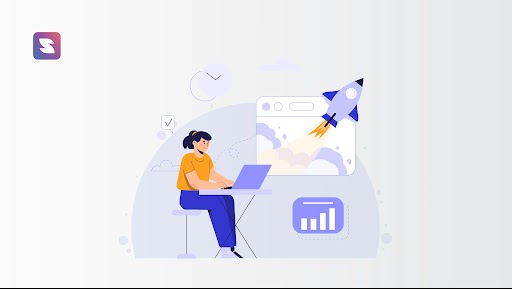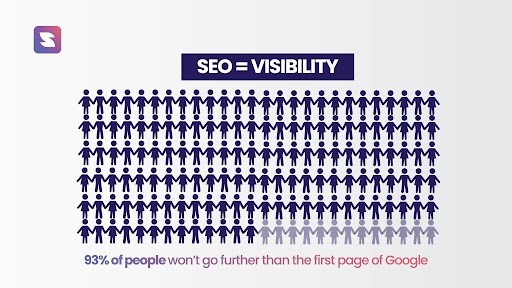Rank on Google's first page in 3 months
12 SEO Tips to Boost Your Organic Rankings & Traffic
Jan 13, 2023 | Karthika Ganesh
Are you tired of being stuck on page 10 of Google’s search results? Are you ready to boost your organic traffic and climb the ranks to the coveted first page?
Look no further!
We’ve compiled a list of 12 tried-and-true SEO tips to boost ranking and traffic. 53.3% of website traffic comes from organic search & your lead generation will climb by 10x if you land the top 3 spots on SERP.
So put on your SEO hat, and let’s get to work – it’s time to boost those rankings and drive some serious traffic to your site!
What’s New on SEO?

Before we jump to the core, let’s take a look around at what’s happening in the search engine optimization world.
Is SEO DEAD???
NO! Not by a long shot, but let’s be real, Google is getting supersaturated. There are over 600 million blogs on the internet and over 7.5 million blog posts published every day in 2022. No wonder it’s tough to get your stuff noticed.
Remember when Google told us to create top-notch, helpful content to rank on the search engine? Yeah, well, people took that advice and ran with it… straight off a cliff.
Writers and SEO experts started pumping out content left and right, and before you knew it, people were building new websites on every niche topic imaginable and cranking out articles that may not actually be that helpful. Quality went out the window.
Now, everyone’s competing with millions of articles, and a ton of people know how to game the system, so they’re ranking their mediocre articles ahead of the good stuff.
And don’t even get me started on all those AI-powered tools like Ryter and Jasper that can crank out long-form, plagiarism-free articles in minutes.
Marketers can now publish even more articles on many different topics daily. Google’s algorithm can’t tell which articles were written by humans and which were created by robots (till now because we SEO experts are sure that “Google will find a way”), so even AI-generated articles can rank.
Do you know an SEO expert’s greatest friend and foe?
It’s Google’s algorithm.
So before we look at those SEO tips to increase website traffic we need to really grab an idea on what those ranking factors are.
SEO Ranking factors for 2023
Factor | Weight |
| Consistent Publication of Engaging Content | 24%▼ |
| Keywords in Meta Title Tags | 15%▼ |
| Backlinks | 15% |
| Niche Expertise | 14%▲ |
| User Engagement | 12%▲ |
| Trustworthiness | 5% NEW |
| Mobile-Friendly / Mobile-First Website | 4% |
| Internal Links | 3% ▼ |
| Page Speed | 3% |
| Site Security / SSL Certificate | 2% |
| Schema Markup / Structured Data | 1% |
| Keywords in URL | 1% |
| Keywords in Meta Description Tags + 19 Other Factors | 1% |
Source – FirstPageSage
Google made some updates to its algorithm in 2023 that are a little different from the previous year. To increase your SEO traffic, you need to know where to strike and which iron’s hot. So here are some SEO ranking factors which you absolutely need to include in your SEO strategy. Take a look at this rundown:
Trustworthiness is the new kid on the block, making up 5% of the algorithm.
User Engagement increased a bit (11% to 12%), holding steady as the fifth most important factor in the algorithm. This factor has been on the rise for the last few years, so it’s safe to say that creating the best response to the searcher’s intent – both explicitly stated and implied – should be the main focus for content creators.
Niche Expertise saw a small bump in value (13% to 14%), further highlighting the importance of Hub and Spoke SEO, which has been one of the most crucial emerging SEO strategies over the past decade. Hub and Spoke SEO are all about creating high-level pages targeting major keywords that link to a bunch of secondary pages targeting closely-related keywords.
Consistent Publication of engaging content slipped a bit from 26% to 24%. This doesn’t really mean much except that the new factor, Trustworthiness, took a little slice from the other factors. Google still rewards consistent producers of high-quality info with quicker indexing and higher rankings. Plus, the more good content you have, the better chance you have to attract backlinks, which is another major factor in Google Trust.
Keywords in Meta Titles went down a bit (17% to 15%) because Google relaxed its definition of what counts as different words.
Internal links took a significant hit (5% to 3%), giving some of its shares to Trustworthiness. While Google Trust is still passed among the pages on your website, it’s not as much of a signal to Google as it used to be.
Backlinks stayed the same at 15%, which shows that this factor – which used to make up over 50% of the algorithm – is still important, just not as much as it used to be. As the fourth most important algorithm factor, it’s a throwback to a time when Google’s AI wasn’t advanced enough to evaluate the quality and trustworthiness of web content on its own and needed other websites to help out.
Keywords in Header Tags got the boot as a factor and have been relegated to the group of 21 factors that only make up 1% of the algorithm altogether.
Words of wise:- Google will penalize your site disproportionately if you fall below a certain threshold for these factors: Keywords in Meta Titles, User Engagement, Trustworthiness, Mobile-Friendliness, and Page Speed.
Tips to boost organic rankings
You are in a never-ending battle to reign supreme in google rankings.
For that, you need SEO content and technical SEO to work in cohesion. SEO brings 1,000%+ more traffic than organic social media. To squeeze the juice out of this market, you need to be #1 in search queries (it takes work, but it’s not impossible).
You must know the basic SEO tips for boosting ranking and traffic, so we’ll skip to the good part. We will zoom in on these tips to make them more specific. Let’s go:
1. Power of keyword gap analysis
Keyword research is the process of identifying the keywords and phrases your target audience is searching for on search engines.
While in a keyword gap analysis, you search for keywords your competitors have used but you haven’t. They target these keywords to gain more traffic and visibility. Running a google “related” search can help narrow down your competition.
Gather those keywords, export them & organize your results. You can use tools like Suitejar to help you easily gather these data.
Take a look at the best keyword-researching tool you can find in 2023
2. Optimize title tags and meta descriptions
Title tags and meta descriptions are HTML tags that provide information about your website to search engines. Title tags are displayed in the search results as the page’s main title and should be optimized to include the target keywords.
Similarly, meta descriptions are short summaries of the page’s content and should be optimized to include the target keywords. Properly optimized title tags and meta descriptions can help increase your website’s click-through rates (CTR).
3. Boost by internal linking
Internal linking is the process of linking to other web pages on your website from within your content. This helps search engines understand the structure of your website and the relationship between your pages. It also helps visitors navigate your website and find related content.
You can boost content on page 2 of a google search. Try to link the pages on page 2 with top-performing pages & you’ll certainly see a visible spike in traffic (after proper execution).
As a complete disclosure – if you are not well-versed in SEO, seek expert help. Even though tools make the job easier for you, laying a solid SEO foundation right from the start will help you in the long run.
4. Remove toxic links
Let me give you a heads up; not every link is your friend. Period!
According to Google’s Link scheme guide, links that manipulate PageRank or a site’s ranking may be considered a part of the link scheme. This includes inbound and outbound links.
Disavow any link that seems fishy without a second thought, and check the link you get before you post them. Do proper research on the prospective site, including their spam scores, to find genuine quality leads.
5. “Steal” high-quality backlinks
Backlinks are links from other websites that point to your website. These links signal to search engines that your website is authoritative and valuable and can help boost your rankings.
Building high-quality inbound links can be done by reaching out to other websites in your industry, guest blogging, and creating valuable content that is likely to be shared and linked to.
Now let’s look at another cheeky way to do this. Your competitors’ broken backlinks are your opportunity. Find those links using SEO tools & reach out to those websites. And it all boils down to your pitch and content.
Do this for a few competitors, and get yourselves quality backlinks. You can sneak a peek into our blog on the best broken-link checker tools here.
6. Top-notch content that screams expertise
Creating high-quality, unique content that is relevant and valuable to your target audience is essential for SEO.
It’s not just about the volume of content but the quality of it. Content that is well-researched, well-written, and provides value to the reader will attract natural links and social shares and reduces bounce rates.
One key thing to remember is that every piece of content on your page reflects you. Google wants to provide its users with the best possible content out there. If your content shows credibility, then the Google algorithm boosts you.
Narrowing down your niche and building content around it is just the start. Try to engage in niche-related topic conversations across platforms and build an expert image.
7. Link those “unlinked” mentions
Do you have sites that just mention you by name and not link to your page? If you don’t know, seek out those honorary mentions and make them your backlinks.
With AI tools, this is one of the easiest actionable SEO tips.
8. Optimize images
Optimizing images is the process of compressing and resizing images to reduce their file size and using descriptive file names and alt tags.
Descriptive file names and alt tags provide a text-based alternative to images for users who may have difficulty loading them. This also helps search engines understand what images are about and can be used for accessibility for visually impaired visitors.
Moreover, doing so will help lower your page load time and makes your website more efficient.
9. Take advantage of SERP features
Google search engine has many features you can use to your advantage. People Also Ask or PAA is a great feature that can help you get improved CTRs or rank you #1 in SERP. Get ranked for featured snippets and be visible above #1 in the SERP.
For that – Use numbered and unnumbered lists, give dictionary-style answers at the start or use questions in subheadings. Another way is to use the structured data type of code to your website’s HTML to help search engines understand the information on your website.
It allows search engines to display featured snippets in the search results, which can help increase your website’s visibility and click-through rate.
10. Make it User-friendly
Who do we love? Users! & how do we show it? look:
Optimize site speed to improve user experience, which is a ranking factor for search engines. This can be done by optimizing images, minifying CSS and JavaScript, and using a content delivery network (CDN).
Many search engines now use mobile-first indexing to determine the rankings of websites. This means that the mobile version of your website is considered the primary version, so it’s important to make sure that your website is mobile-friendly and responsive.
11. Check your vitals
Tracking and analytics tools like Google Analytics can be used to monitor your website’s performance, identify areas for improvement, and track your progress over time. This can help you understand how users interact with your website, which pages are performing well, and which areas need optimization.
Check your core web vitals like
- LCP (largest contentful paint) – ideal data is 2.5 seconds or faster.
- FID (first input delay) – ideally less than 100 milliseconds.
- CLS (cumulative layout shifts) – ideally less than 0.1
12. Digital PR
Engage with your target audience by responding to comments and feedback and by actively promoting your content on social media. Reach out to websites for links, connect with influencers to promote your content & improve your digital marketing strategy.
What if you do all this, and Google still torments you with its algorithm? Don’t worry we got you.
This next section is to prep you for the unstable google algo.
Future proof your SEO

Want to know something Interesting? Google changes its algorithm roughly 4500 times.
Now don’t start biting your nails off. Most of these updates are so tiny that it barely scratches SEO ranking factors. But these core updates are on another level, and your future-proofing strategy should be centred around those changes.
Think about this for a moment, what is google’s aim with these updates?
USER EXPERIENCE!
Focus on your user experience, and you get yourself the first solid footing to future-proofing your SEO. Shift your content strategy for end users, and rankings will follow.
If your users get what they are looking for and linger for more time on your blog, ranking factors in SEO will become secondary. There are a few ways to prioritize user experience and give what they want. Look at what they are.
Load faster
We hate it when we have to wait for a page to load. Make sure your page loads super fast, and one way to ensure that is by reducing the weight of the images you use.
21% of page weight is from images – the dimensions, the quality, how it looks on different screens and how you optimize it play major roles in it.
Competitive research
Find out the right keywords you rank for using tools like google search console and search those keywords in a new incognito tab. You’ll see who ranks better than you. Do a proper breakdown of why they rank above you.
Look for patterns and commonalities among the pages and use this information to guide your own content strategy. Instead of copying your competitors, use this information to improve upon their approach and create something unique and better.
For example, consider the length of their content, the types of posts they publish, and the visual assets they use. Use this information to inform your own decisions on format, topics, and media, and aim to replicate what is already working in a superior way.
Quick solution
Imagine this, you ask Google, “what’s 2+2?” and it gives you a blog with 3000 words to read, and at the end, you get “4”. People google search for solutions to their problems and if you can give that solution in 100 words, DO IT!
Use tools
Use SEO tools like the rank tracking tool, keyword research tool, heat mapping tools and so on to leverage and improve your SEO strategies fully. Keep track of the keywords you are ranking and the keywords you want to rank, do proper keyword research, adequate competitor analysis, find backlink gaps and more. User heat maps help you identify which part of your page causes users to bounce.
Words of wise – Don’t be alarmed, Google will release updates and these might affect your traffic.

But you’re optimizing your content for your users. When Google releases the changes they made weren’t best for end users they will change it. You’re in it for the long game.
Wrap-up
Implement these SEO tips to boost ranking and traffic and double your quality leads but it’s important to remember that SEO is an ongoing process that requires patience and persistence.
As you can see, to improve your SEO strategies and yield better results, you will have to depend on good SEO tools. SuiteJar is a free SEO tool that can help you build the right SEO strategy for your business.
And, if you feel like you are not well-versed in the technical aspect of it or you are short on time, It’s best to seek expert advice or partner with experts to help you with your SEO strategy and ensure that your website is optimized to its full potential.